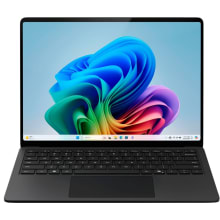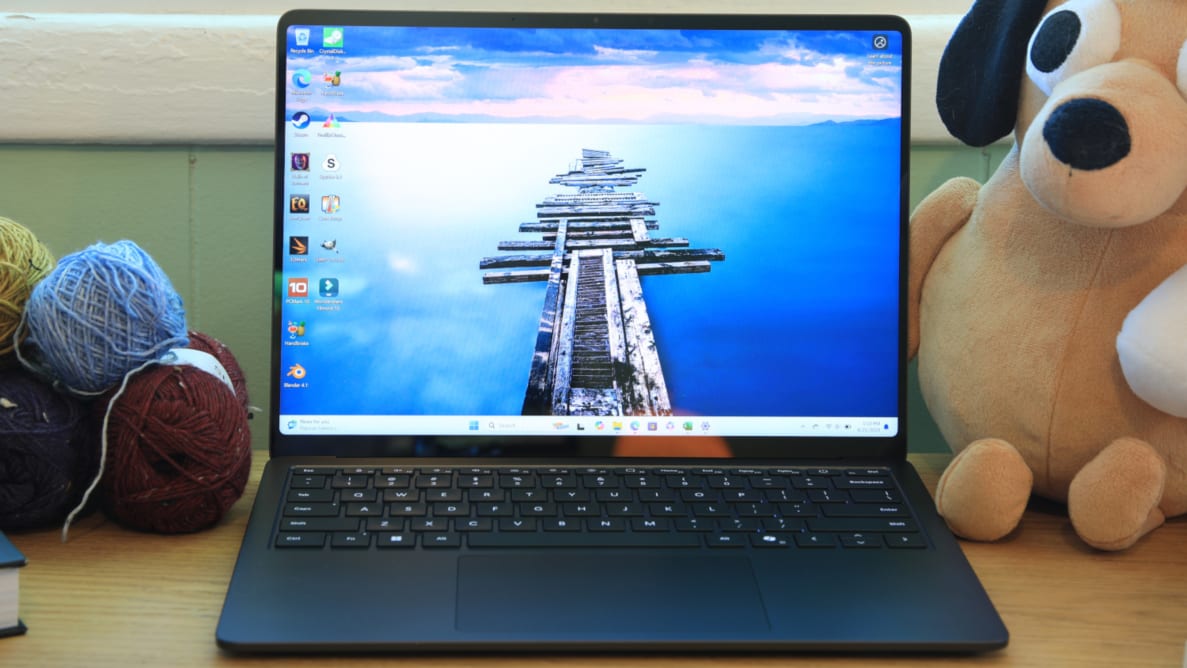Pros
-
Strong CPU performance
-
Excellent battery life
-
Attractive, functional design
Cons
-
No HDMI or Ethernet
-
Gaming performance disappoints
-
AI-enabled features fall flat
About the Microsoft Surface Laptop 7th Edition 13.8-inch

The new Surface laptop use Qualcomm chips instead of Intel, with the base using the Snapdragon X Plus while the upgraded version comes with the X Elite.
The Microsoft Surface Laptop’s specifications are intriguing. The base Surface Laptop 13.8-inch starts at $1,000 for a 10-core Qualcomm Snapdragon X Plus processor, 16GB of RAM, and 256GB of solid-state storage.
We tested an upgraded version of the 13.8-inch laptop with a 12-core Snapdragon X Elite processor, 32GB of RAM, and 1TB of storage, which doubles the MSRP to $2,000. Users can choose to upgrade the storage themselves, but the RAM is soldered to the board, so there’s no way to upgrade the RAM later.
Microsoft also sells a 15-inch ARM Surface Laptop. It starts at $1,500 for a 12-core Snapdragon X Elite processor, 16GB of RAM, and a 512GB solid-state drive. Though it starts at a higher price, the 15-inch model is barely more expensive than the 13.8-inch model when identically configured. A 15-inch Surface Laptop with a 12-core processor, 32GB of RAM, and 1TB of storage is $2,100.
While the Surface Laptop’s specifications are impressive, shoppers should remember that the Qualcomm Snapdragon X is an ARM processor. Many Windows apps aren’t programmed for ARM, so Microsoft uses an emulation layer, Prism, to maintain compatibility. That can reduce performance, so check if your favorite apps have an ARM version available before buying the Surface Laptop.
With that said, many popular apps from Google Chrome to Adobe Photoshop, either have ARM versions or have announced a future ARM release.
Microsoft Surface Laptop 7th Edition specs:
- Price as configured: $2,000
- Processor: Qualcomm Snapdragon X Elite (12-core)
- Graphics: Qualcomm Adreno integrated graphics
- Memory: 32GB LPDDR5x at 8448MHz
- Storage: 1TB PCIe 4.0 M.2 solid-state drive
- Display: 13.8-inch, 3:2, 2,304 x 1,536 3:2 120Hz IPS touchscreen, maximum brightness 607 nits (measured), 98% of DCI-P3 color gamut (measured), 1,250:1 contrast ratio (measured)
- Ports: 2x USB-C (Thunderbolt 4, DisplayPort Alternate Mode, and USB Power Delivery), 1x USB-A, 1x Surface Connector, 1x 3.5mm combo audio jack
- Connectivity: Wi-Fi 7, Bluetooth 5.4
- Camera: 1080p webcam with IR for Windows Hello login
- Battery: 54 WHr
- Weight: 2.96 pounds (1.34 kilograms)
- Dimensions: 11.85 x 8.67 x 0.69 inches
- Warranty: 1-year limited manufacturer warranty
- Special features: 45 TOPS Qualcomm Hexagon Neural Processing Unit (NPU)
What we like
The performance rivals x86 competitors

The Microsoft Surface Laptop's processor is fast, rivaling the best on the market from Apple and Dell.
The Qualcomm Snapdragon X processor in the new Microsoft Surface Laptop has a lot to prove. Qualcomm processors have shipped in Windows devices before, but they’ve always lagged the best AMD and Intel chips.
No longer. The 12-core Snapdragon X Elite in our Surface Laptop achieved a Geekbench 6 single-core score of 2,276 and a multi-core score of 13,086. The single-core score falls behind the Apple MacBook Air M3’s 3,076, but the Air M3 was slower in the multi-core test with a score of 12,089. The Dell XPS 14 with an Intel Core 7 155H Ultra lags the Surface Laptop in both. It scored 2,315 in single-core and 12,191 in multi-core tests.
The Surface Laptop didn’t score as well in Cinebench R23, where it hit a multi-core score of 8,834. That’s behind the MacBook Air M3 and XPS 14, which scored 12,089 and 12,859, respectively. However, this benchmark doesn’t run natively on the Qualcomm processor, which hurts performance.
Blender, like Geekbench, runs natively and allows the Qualcomm chip to strut its stuff. The Surface Laptop used the CPU to render the BMW27 test file in 3 minutes ,and 5 seconds. That’s two seconds quicker than the Dell XPS 14 and far faster than the Air M3, which finished in 5 minutes and 7 seconds.
While the Qualcomm chip scored well in CPU benchmarks, it was less impressive in graphics tests. 3DMark’s Wild Life Extreme returned a score of 5,796. That’s behind the Air M3 and XPS 14, which respectively scored 8,284 and 18,453. The XPS 14’s much higher result is thanks to the laptop’s mobile Nvidia RTX 4050 GPU. Qualcomm chips don’t support Nvidia or AMD GPUs, so the Surface Laptop can’t compete here.
Content creators who need GPU acceleration should avoid the Surface Laptop for similar reasons. The Qualcomm chip’s performance isn’t far off other entry-level graphics options, like Intel Arc or AMD Radeon 780M integrated graphics. But the lack of GPU options and the inability to use an external GPU, is a barrier in any app that can make use of (or requires) a dedicated graphics card.
Most apps work well
The Qualcomm Snapdragon X chip in the Microsoft Surface Laptop heralds a new era for Windows. Until now, nearly all Windows PCs had an Intel or AMD processor and used an instruction set called x86. Qualcomm’s chip instead uses an instruction set called ARM. Put simply, x86 and ARM chips speak different languages.
The results from the Prism translation layer are surprising. With one notable exception, none of the apps we tried in our time with the Surface Laptop failed to launch or crashed during use. A majority of the apps we rely on have an ARM-compatible release for Windows (though some are in beta). This includes Google Chrome, Adobe Photoshop, GIMP, Notepad++, Netflix, and Zoom, to name a few.
Okay, but what’s that exception? Games.
Very few Windows games are developed for ARM, so nearly all will run through emulation. This can reduce performance even in 2D games like Slay the Spire or Halls of Torment. Other titles, like Counter-Strike 2, PUBG: Battlegrounds, and Warframe, either failed to launch or experienced unusual performance issues (like intermittent lock-ups) that made them unplayable.
PC gamers should give the Microsoft Surface Laptop a wide berth. But if you mostly use common productivity apps from Microsoft or Adobe, or stick to browsing the web and watching Netflix, app compatibility shouldn’t be a problem.
The impressive battery life
You might wonder: why switch to Qualcomm at all? The Microsoft Surface Laptop’s battery life is the answer.
The Surface Laptop endured our battery life test, which uses a browser plug-in to simulate web browsing with the display set to 200 nits until the laptop dies, for a spectacular 22 hours and 43. That’s the second-best battery life result we’ve ever recorded, and the best for a Windows device. It’s beaten only by the Apple MacBook Pro 14 M2, which lasted 24 hours and 12 minutes.
Competing Windows laptops priced about the same, like the Dell XPS 14 and Framework Laptop 13 AMD Edition, typically last 10 hours or less.
Battery life isn’t as impressive in demanding apps (the same is true of Apple’s MacBook line), but the Surface Laptop’s test result didn’t differ too much from competitors. Expect 15 to 20 hours of real-world use.
Design and build
Microsoft’s Surface devices have always ranked among the most attractive and robust Windows laptops, and the Surface Laptop 7th Edition is no exception.
It has an aluminum body that looks great on a desk and feels rigid in hand. Microsoft leans on subtle design decisions, like rounding the corners of the display and tapering the edges of the laptop’s body to craft a more premium, modern feel.
It’s light and thin, too, at 2.96 pounds and just 0.69 inches thick. Competitors like the Apple MacBook Air M3 and Dell XPS 13 are a bit thinner and lighter, but also have slightly smaller screens. The Asus ROG Zephyrus G14 is thinner, too (a surprise, since it’s a gaming laptop), but weighs a few ounces more.
The seventh-generation Surface Laptop has a 13.8-inch display with a 3:2 aspect ratio. That equates to a display height that’s identical to a 15.6-inch laptop with a 16:9 aspect ratio, but roughly two inches narrower. That means the Surface is outstanding for anything with a vertical orientation, like reading Word documents and PDFs.
Of course, the reverse is also true. Any content wider than it is tall will look awkward. That includes most streaming shows and films, as well as widescreen photos and digital art. The letterboxing required when watching movies and streaming shows is distracting, not only because of the size of the bars but also because the IPS display can’t achieve a true, inky black like an OLED screen can. It’s a tradeoff, but people who work with text or code will like it.
What we don’t like
The keyboard is mediocre

The keyboard's layout is decent but lacks adequate tactile feedback.
The Microsoft Surface Laptop takes a loss on the keyboard. The problem is key feel.
Each key has respectable travel but activates with a vague, ill-defined bottoming action that lacks tactile or audible feedback. That caused issues when typing at high speeds. My fingers sometimes felt they had activated a key when, in fact, they hadn’t. It’s possible we would eventually adjust to the keyboard, but we’d rather not have to.
Competitors have the Surface Laptop beat. The Dell XPS 14, Apple MacBook Air M3, and Lenovo Slim 7 all provide a better keyboard.
It’s not all bad news. The keyboard layout is spacious, there’s ample room between keys, and the palm rest is comfortable. The touchpad is large and responsive, measuring roughly five inches wide and over three inches deep, with effective palm rejection to prevent unintended input. It also has haptics that simulate the feel of a mechanical mouse click when tapping the touchpad’s surface.
Wired connectivity is limited
The Microsoft Surface Laptop has just two USB-C ports, one USB-A port, and a 3.5mm combo audio jack. It lacks HDMI and Ethernet ports, as well as SD card or MicroSD card readers.
The USB-C ports partially make up for these limitations. Both support Thunderbolt 4, USB 4, DisplayPort Alternate Mode for video connectivity, and USB Power Delivery for charging. Their versatility makes them compatible with a wide range of USB-C hubs, adapters, docks, chargers, displays, and peripherals.
Microsoft also stuck with the divisive Surface Connect charger. It’s a magnetic charging and data port only compatible with the company’s chargers and docks. Dedicated Microsoft fans might like this, as it maintains compatibility with older Surface docks and chargers. But it’s less appealing to new Surface owners, as Surface Connect docks tend to be expensive.
While wired connectivity is light, wireless connectivity is excellent. The Surface Laptop 7th Edition has Wi-Fi 7 and Bluetooth 5.4, the latest version of each wireless standard. You’ll need a Wi-Fi 7 router to see any improvement, but it’s good to see Microsoft take a forward-looking approach to Wi-Fi.
The Copilot+ PC launch is a bust
Microsoft announced the Surface Laptop 7th Edition at the company’s developer conference, Build 2024, as part of a marketing blitz for Copilot+ PCs from multiple laptop makers including Acer, Asus, Dell, and Lenovo.
They were pitched as AI-focused laptops with built-in Neural Processing Units (NPUs) several times more capable than anything in previous laptops. The 2024 Surface Laptop has an integrated Hexagon NPU that can handle 45 trillion operations per second (TOPs). That’s twice the performance of Apple's MacBook Air M3, which delivers just 18 TOPs.
But the Hexagon NPU is all dressed up with nowhere to go.
Microsoft Recall, a feature that will use the NPU to memorize and recall anything opened, viewed, or used on a Copilot+ PC, was delayed after the feature’s security safeguards were questioned. It’s now slated to enter beta a few weeks after the Surface Laptop launches. Even when it arrives, it will be off by default.
A few other features remain, and they have their uses. Copilot+ PCs can use the NPU to translate language in video or audio calls in real time, add filter effects to video calls, and convert Microsoft Paint sketches into more detailed images. But these features are already available from other apps and services.
There’s also a disappointing lack of third-party apps that use the NPU. No third-party Windows software currently supports using the Hexagon NPU to run AI tasks on-device. That should change, as Microsoft laid out its plans for AI app development at Build 2024. At the time of writing it’s unclear when that will translate to useful new features in popular apps.
Should you buy the Microsoft Surface Laptop 7th Edition?
Yes, it raises the bar on battery life for Windows laptops

Big gains in processing power and battery life make this laptop a level-up for Microsoft.
Microsoft’s new Surface Laptop was built to redefine the Windows laptop experience, and it partially succeeds. The new Qualcomm Snapdragon X chip can go toe-to-toe with Apple’s M3 in processor performance and defeats Intel’s Core Ultra 7. It’s also far more efficient than prior AMD and Intel processors, which boosts the Surface Laptop’s battery life to the top of its class.
Surprisingly, the switch to Qualcomm doesn’t cause major problems for app compatibility. Nearly all the apps we tried worked well and many had versions developed for ARM processors like the Snapdragon X. We didn’t experience stability issues in Windows or in productivity apps and software. Games are the exception, and many perform poorly, including some 2D games.
The Surface Laptop’s pricing is also a bit high. Lenovo’s Slim 7 offers similar performance at a much lower price. Apple’s MacBook Air M3 13.6-inch is more expensive to start, but an Air M3 with RAM and storage similar to the Surface Laptop costs $100 less. Lenovo, Asus, Acer, and Dell have also launched laptops with Qualcomm processors, and while they’re more expensive to start, they tend to be much less expensive when upgrades are applied. The 2024 Lenovo Yoga Slim 7x with 32GB of RAM and 1TB of storage, for example, is roughly $1,300 and includes an OLED screen.
That takes some of the shine off Microsoft’s new Surface Laptop, but plenty of luster remains. Shoppers looking to stick with Windows won’t find a more portable PC—with the possible exception of the new Surface Pro tablet, which offers the same Qualcomm Snapdragon X Plus and Elite chips.

The Surface Laptop 7th Edition hammers out (most of) ARM’s kinks for a solid laptop with class-leading battery life.
Meet the tester
Matthew S. Smith is a veteran tech journalist and general-purpose PC hardware nerd. Formerly the Lead Editor of Reviews at Digital Trends, he has over a decade of experience covering PC hardware. Matt often flies the virtual skies in Microsoft Flight Simulator and is on a quest to grow the perfect heirloom tomato.
Checking our work.
Our team is here to help you buy the best stuff and love what you own. Our writers, editors, and experts obsess over the products we cover to make sure you're confident and satisfied. Have a different opinion about something we recommend? Email us and we'll compare notes.
Shoot us an email




